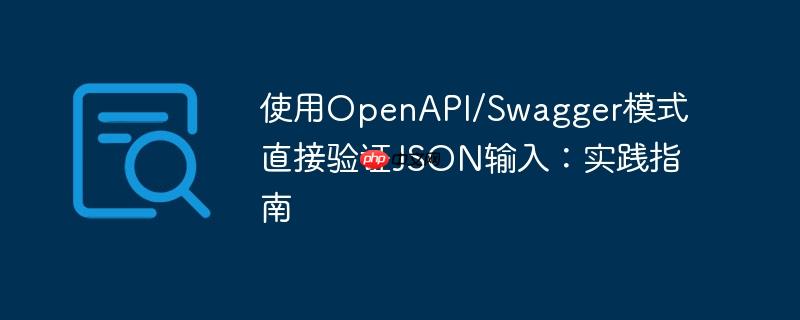
在api开发中,对传入的json数据进行验证是确保系统稳定性和数据完整性的关键环节。传统的验证方式,例如将json输入首先转换为java pojo(plain old java object),然后再对pojo进行字段级别的校验,虽然有效,但在面对复杂的api接口或频繁的模式变更时,会带来额外的开发负担和维护成本。这种方法需要手动维护pojo与json模式之间的一致性,容易出现同步问题。
随着API设计标准化的普及,OpenAPI(前身为Swagger)已成为定义RESTful API接口事实上的标准。OpenAPI规范不仅描述了API的路径、操作和参数,更重要的是,它通过Schema定义了请求体和响应体的JSON数据结构。利用这些预定义的Schema直接验证JSON输入,可以大大简化验证流程,提高开发效率,并确保数据严格遵循API规范。
OpenAPI和Swagger是描述、生成和可视化RESTful API的强大工具集。OpenAPI Specification(OAS)是其核心,它提供了一种语言无关的接口描述语言(IDL),用于描述API的各个方面,包括:
通过OpenAPI规范,我们可以清晰地定义API期望接收的JSON数据格式。这意味着,只要我们拥有API的OpenAPI定义文件(通常是YAML或JSON格式),就可以利用其中的Schema来直接验证任何传入的JSON数据。
为了实现JSON输入与OpenAPI/Swagger Schema的直接验证,我们可以利用专门的解析和验证库。以Java生态为例,openapi4j-parser是一个非常推荐的工具。它是一个功能强大的库,能够解析OpenAPI 3.x规范,并提供数据验证功能。

Easily find JSON paths within JSON objects using our intuitive Json Path Finder
 30
30

openapi4j-parser库允许开发者:
以下是使用openapi4j-parser进行JSON验证的基本步骤和示例代码:
步骤1:添加依赖 首先,在你的Java项目(如Maven或Gradle)中添加openapi4j-parser的依赖。
<!-- Maven 示例 -->
<dependency>
<groupId>org.openapi4j</groupId>
<artifactId>openapi-parser</artifactId>
<version>2.0.0</version> <!-- 请使用最新稳定版本 -->
</dependency>
<dependency>
<groupId>com.fasterxml.jackson.core</groupId>
<artifactId>jackson-databind</artifactId>
<version>2.15.2</version> <!-- 确保与你的项目兼容 -->
</dependency>步骤2:加载OpenAPI Schema 从文件、URL或字符串中加载OpenAPI规范定义。
import org.openapi4j.core.model.v3.OpenApi3;
import org.openapi4j.parser.OpenApi3Parser;
import org.openapi4j.parser.model.v3.Schema;
import org.openapi4j.parser.validation.v3.ValidationApi;
import org.openapi4j.core.validation.ValidationResults;
import com.fasterxml.jackson.databind.JsonNode;
import com.fasterxml.jackson.databind.ObjectMapper;
import java.io.File;
import java.io.IOException;
import java.net.URL;
public class JsonSchemaValidator {
public static void main(String[] args) {
try {
// 假设你的OpenAPI定义文件在resources目录下或可通过URL访问
// File openApiFile = new File("src/main/resources/openapi.yaml");
URL openApiUrl = new URL("file:///path/to/your/openapi.yaml"); // 或 http://your-api.com/openapi.json
// 1. 解析OpenAPI规范
OpenApi3Parser parser = new OpenApi3Parser();
OpenApi3 api = parser.parse(openApiUrl);
// 检查解析过程中是否有错误
if (api == null) {
System.err.println("Failed to parse OpenAPI document.");
return;
}
// 假设我们要验证的JSON数据对应于OpenAPI定义中名为"MyRequestBody"的Schema
// 这个Schema通常定义在 components/schemas 下
Schema targetSchema = api.getComponents().getSchemas().get("MyRequestBody");
if (targetSchema == null) {
System.err.println("Target schema 'MyRequestBody' not found in OpenAPI document.");
return;
}
// 2. 准备待验证的JSON数据
String validJsonInput = "{\"name\": \"Alice\", \"age\": 30, \"email\": \"alice@example.com\"}";
String invalidJsonInput = "{\"name\": \"Bob\", \"age\": \"twenty\", \"email\": \"invalid-email\"}"; // age类型错误, email格式错误
ObjectMapper mapper = new ObjectMapper();
JsonNode validJsonNode = mapper.readTree(validJsonInput);
JsonNode invalidJsonNode = mapper.readTree(invalidJsonInput);
// 3. 执行验证
System.out.println("--- 验证有效JSON ---");
ValidationResults validResults = new ValidationApi(api).validate(validJsonNode, targetSchema);
if (validResults.has Errors()) {
System.out.println("有效JSON验证失败:");
validResults.getErrors().forEach(System.out::println);
} else {
System.out.println("有效JSON验证成功!");
}
System.out.println("\n--- 验证无效JSON ---");
ValidationResults invalidResults = new ValidationApi(api).validate(invalidJsonNode, targetSchema);
if (invalidResults.has Errors()) {
System.out.println("无效JSON验证失败,错误详情:");
invalidResults.getErrors().forEach(System.out::println);
} else {
System.out.println("无效JSON验证成功 (这不应该发生)!");
}
} catch (IOException e) {
System.err.println("Error reading OpenAPI file or JSON input: " + e.getMessage());
} catch (Exception e) {
System.err.println("An unexpected error occurred: " + e.getMessage());
e.printStackTrace();
}
}
}示例openapi.yaml片段: 为了使上述代码能够运行,你的openapi.yaml文件需要包含一个名为MyRequestBody的Schema定义,例如:
openapi: 3.0.0
info:
title: Sample API
version: 1.0.0
paths: {}
components:
schemas:
MyRequestBody:
type: object
required:
- name
- age
- email
properties:
name:
type: string
description: User's full name
age:
type: integer
format: int32
minimum: 0
description: User's age
email:
type: string
format: email
description: User's email address直接使用OpenAPI/Swagger Schema验证JSON输入是现代API开发中的一项重要实践。它不仅提升了API的健壮性和数据一致性,还通过自动化验证流程,显著提高了开发效率和可维护性。通过利用openapi4j-parser等专业工具,开发者可以轻松地将这一强大的验证机制集成到其应用中,确保API始终以高质量、高可靠性运行。
以上就是使用OpenAPI/Swagger模式直接验证JSON输入:实践指南的详细内容,更多请关注php中文网其它相关文章!

每个人都需要一台速度更快、更稳定的 PC。随着时间的推移,垃圾文件、旧注册表数据和不必要的后台进程会占用资源并降低性能。幸运的是,许多工具可以让 Windows 保持平稳运行。




Copyright 2014-2025 https://www.php.cn/ All Rights Reserved | php.cn | 湘ICP备2023035733号